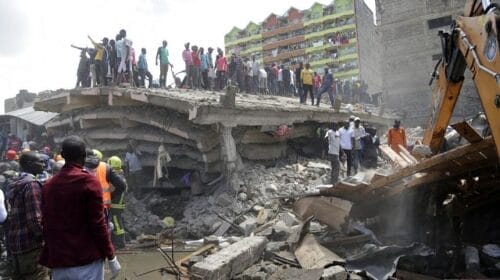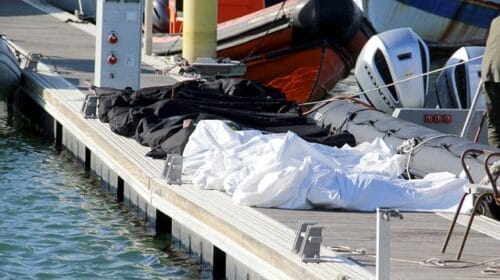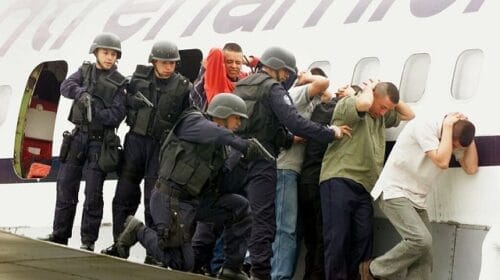Ghana coronavirus: case count hits 1,279; two new regions ‘infected’

April 24: Ghana records 125 more cases
The coronavirus case count in Ghana has reached 1,279. Which indicates an increase of 125 new cases since the last tally was released on April 22. The previous increase was by 112, the first since the lifting of a partial lockdown.
The country has also recorded four more recoveries to bring the tally to 124 whiles a new death takes the tally to 10. Two regions recorded their index cases, Oti and Western North regions with the Greater Accra region maintaining its yawning lead as the epicenter.
Ghana is sub-Saharan Africa’s third most impacted country with the current tally behind South Africa and Cameroon with 3,953 and 1,430 cases respectively.
The West African country has in the past overtaken three other countries to becomes the region’s most impacted. Senegal, Burkina Faso and Ivory Coast have in the past been the top infected till recently.
West Africa’s most impacted as of April 24
Ghana – 1,279
Ivory Coast – 1,004
Nigeria – 981
Guinea – 862
Niger – 671
Burkina Faso – 616
Senegal – 545
Police deployed to hot spots to be tested
Over 8,000 police officers are to be tested for COVID-19 after they were deployed in virus hot spots during a three-week lockdown that was lifted last Sunday by President Akufo-Addo. They were part of 30,000 police – military deployment.
The figure represents about one-third of officers deployed over the period to enforce the measure meant to curb spread of the virus which has so far affected over 1,000 people in the West African nation.
The lockdown on the capital and two other metropolis was lifted at a time many expected an extension but government insists the lifting is backed by data and improved testing admitting an economic aspect too.
However, schools remain closed, authorities are enforcing a ban on public gatherings, borders remain closed and the wearing of face masks decreed across the Greater Accra region as at April 22.
About 800 people are facing prosecution for infractions during the three-week period. Ghana has recorded 1,154 cases of COVID-19 – making it West Africa’s most impacted – recoveries are at 120 including nine deaths as of April 24.
[embedded content]
April 23: Capital Accra to enforce wearing of masks
Days after a three-week lockdown was lifted on the capital Accra and two other metropolis, the Greater Accra Regional minister has announced a compulsory use of face masks in public.
An April 22 statement signed by minister Ishmael Ashitey said the regional coordinating council had met in an emergency meeting as part of efforts to enforce the president’s directives on social distancing and the wearing of masks.
Some of the measures agreed include the following: Mandatory wearing of face masks in public across the region, sensitization on the measure and on social / physical distancing by sub-regional authorities.
Sub-regional authorities to educate traders on the measures above, commercial drivers to only allow passengers with masks on board, “NO FACE MASK, NO ENTRY” signs to be posted outside public places like offices, lorry stations, shops, markets, malls, banks, pharmacies etc.
Satellite markets are also to be created to help decongest main markets and a temporary ban imposed on all “Special Market Days” in the region.
GHANA ??
With immediate effect, everyone in the Greater Accra Region must wear face masks. pic.twitter.com/CKLNeqaRhi
— Gary #StayAtHome (@garyalsmith) April 23, 2020
Tally hits 1,154 with 21 more recoveries
The coronavirus case count in Ghana has increased to 1154. Which indicates an increase of 112 new cases since the last tally was released on April 19 when the president lifted a partial lockdown.
The country has also recorded 120 recoveries. This was announced by the Ghana Health Service at a press briefing on Wednesday, April 22, 2020, in Accra.
Meanwhile, the presidential advisor on health, Dr Nsiah-Asare, has in an interview indicated that 10% of the Ghanaian population may probably test positive for the virus before the country’s case count on coronavirus gets to the peak of the infection. Ghana’s population is estimated at over 28 million.
A day after meeting members of the Ghana Medical Association, the president met with the Council of State – an advisory body of eminent leaders, to brief them on issues surrounding the COVID-19 fight.
Meanwhile, the capital Accra and capital of the resource-rich Ashanti region,Kumasi; breezed into life after the lifting of a three-week lockdown. The two areas along with Kasoa metropolis in the Central Region were locked down last month.
The lifting of the measure, the first across Africa, has since elicited exchanges over its propriety but the president defended the decision stressing that it was based on data and science and that it was to help cushion people in the informal sector.
April 21: President defends lifting of lockdown as opposition NDC kicks
President Akufo-Addo on Monday defended the decision of government to lift a partial lockdown on the capital and two other key metropolis in the West African country.
The president told member of the Ghana Medical Association, GMA, during a meeting at the presidency that data on testing and contact tracing along with treatment of confirmed cases informed the decision announced on Sunday, April 19.
He also stressed that a crucial plank of the economy, the informal sector, were also a major factor to the decision, which has so far divided opinion in the country.
He said in part: “we are also looking at the demography of the disease itself, in terms of the sick, in terms of death.
“What we will like to do, as decision makers, is to balance all these factors and to come to a conclusion and a set of solutions that will benefit our people and of course, protect the economy of our country. All of these have been the basket of issues that have led us to take this decision.”
As President of the Republic, he continued: “I cannot ignore the impact that this lockdown is having on several constituencies of our nation, especially the informal workers, a very important part of our economy, who need to have a day out in the market or otherwise in order to provide for their families, who were having a lot of difficulty.”
The GMA leadership said they were ready to play their part in ensuring that Ghana beats the virus. There has been a series of reactions to the lifting of the lockdown across a broad section of the society.
The Trade Union Congress voiced support for the lifting of the measure. Head of a think tank, the Institute of Statistical, Social and Economic Research, also voiced backing for the move. People jubilated in parts of the country when the lockdown was lifted.
The main opposition National Democratic Congress, NDC, is however unhappy at the development with its spokesman accusing the president of not valuing the lives of Ghanaians at a time when confirmed cases continued to rise.
Meanwhile, the NDC’s current leader and former president John Dramani Mahama continues his food distribution efforts in the Greater Accra Region. Mahama has also made donations to to a number of public hospitals across the country.
One of the country’s renowned pathologists, Prof Agyemang Badu Akorsah, bemoaned the lifting stressing that conditions pointed to the need for the lockdown to have been extended.
April 19: Ghana lifts partial lockdown
Ghana’s president on Sunday lifted targeted lockdown on two major regions in the country citing improved testing of the coronavirus pandemic across the West African country.
In the over half-an-hour address delivered to the nation, the president also announced that Ghana’s tally had passed the 1,000 mark. Ghana becomes the first African country to not extend but lift a lockdown.
Rwanda, South Africa, Uganda and more recently Zimbabwe have all extended lockdowns aimed at curbing spread of the pandemic. Government however warned that lockdowns could be imposed in hotspots if need be.
Some key facts from the address included:
- Ghana has traced 86,000 contacts so far
- 68,500 of the number have since been tested
- 18,000 test results expected
- 1,042 (1.5%) confirmed cases as of April 19
- 67,549 (98.5% negative) tested negative
- 930 people responding to treatment at home or government facilities
“Indeed Ghana is the only other country in Africa to have conducted more than 60,000 tests and we are ranked number pone in Africa in administering of tests per million people. The decision to impose restrictions on movement was backed by the data at hand and our next course of action is backed by data and by science,” the president said.
April 18: Ghana shoots to sub-Saharan Africa’s third most impacted
After a day without release of figures, i.e. April 17; government released latest figures relating to the COVID-19 pandemic in Ghana. The case count stands at 834 which indicates an increase of 193 patients.
The cases were recorded across the country according to officials. There was also good news for recoveries which also went from 83 to 99 indicating an increase of 16.
The new case count means that Ghana is sub-Saharan Africa’s third most impacted nation behind South Africa with over 2,700 cases and Cameroon with 1,017 confirmed cases.
Meanwhile Pariliament has approved a $1bn interest-free loan facility given by the International Monetary Fund, IMF, earlier this week to help cushion the country from the effects of the ongoing pandemic, local news outlet Citi News reported
Ghana was at high risk of debt distress, the IMF said in a statement. It said the large disbursement of emergency aid would help the West African countries address urgent fiscal and balance of payments needs, and catalyze support from other development partners.
April 17: Recoveries recover by 66
Ghana’s COVID-19 statistics as of April 16 stood at 641, with five new cases recorded, 83 recoveries and eight deaths, the information Minister Kojo Oppong Nkrumah told a press briefing in the capital Accra.
The figure especially relative to recoveries was the biggest one-day rise. The latest figure of 83 meant that 66 more recoveries had been added to the paltry 17 of the day before.
The tally is still on the low side comparative to other countries that have recorded 400 cases and above. Ivory remains West Africa’s most impacted country along with Ghana, Burkina Faso, Nigeria, Niger and Senegal.
WEST AFRICA’S MOST IMPACTED NATIONS: As of April 7 (Case, recovery)
- Ivory Coast = 688, 193
- Ghana = 641, 83
- Niger = 609, 105
- Burkina Faso = 546, 257
- Nigeria = 442, 152
- Senegal = 355, 194
April 15: Ghana’s coronavirus figures: galloping cases, snail-pace recoveries
The West African nation of Ghana is one of the continent’s most impacted countries in terms of coronavirus infection. The country has recorded 636 confirmed cases (as of April 15). The first cases were confirmed on March 12, 2020.
The government has been lauded for its progress in the area of testing, Ghana placed a distant second behind South Africa according to a recent report by Worldometer – a site that specializes in global statistical aggregation.
Three day boom – 408 to 636
Ghana as of April 11, 2020 had tested over 37,000 people and at the time had 408 cases. Ghana was sandwiched between South Africa and Egypt in first and third spots with 73,000+ tests (1,265 cases) and 25,000 tests (1,204) cases respectively.
Three days later, Ghana’s tally had increased to 636, the second highest in the sub-region only behind neighbouring Ivory Coast which had recorded only two cases more with 638 cases. Ghana’s biggest jump over the three-day period being 158 cases from 408 (April 11) to 566 (April 12).
By April 14, another 70 cases have been recorded bringing the tally to 636. Information Minister Kojo Oppong Nkrumah in reacting to the increase in cases stressed that it was largely due to proactive measures by government.
He wrote in a tweet thread of April 13: “The mix of measures to aggressively go in search of it while limiting importation is the reason for which we have found 274 more cases.
“The enhanced tracing and testing coupled with the mandatory quarantine systems is yielding results. Had we not adopted this approach, the 274 extra will be with us potentially continuously spreading the virus.” That was before 70 more cases brought the tally to the current 636.
Recoveries in need of recovery
Recoveries in relation to COVID-19 are a key pointer to how treatment of cases is progressing. As a norm across most African countries, recoveries outnumber deaths – in fact, the same is the case globally.
But Ghana’s recovery figures are much lower compared to countries that have passed the 500 mark in terms of infections. Senegal at a point Africa’s most impacted currently reports 299 cases with 183 recoveries, two deaths – the first being a celebrated son of the land, Pape Diouf.
Burkina Faso took over from Burkina with a surge in cases weeks back. Yet Ghana’s northern neighbour’s tallies stand at 528 cases, 177 recoveries and 30 deaths. Ivory Coast the ECOWAS leader has 638 cases, 114 recoveries and 6 deaths.
With 636 cases, Ghana’s 17 recoveries is dwarfed by neighbours whose recoveries are in the hundreds. Nigeria with 373 cases has recorded 99 recoveries and 11 deaths, Niger with 570 cases had also recorded 90 recoveries. One thing is clear, and that is, in the absence of a boom in recoveries, Ghana’s recoveries need recovery.
Worryingly yet, according to the Ghana Health Service website, only two out of the total number of active cases are
in critical condition.
Quick Statistics: Ghana COVID-19 file
- Confirmed case = 636
- Recoveries = 17
- Deaths recorded = 8
- Regions impacted: 10 out of 16
- Most impacted region: Greater Accra Region




